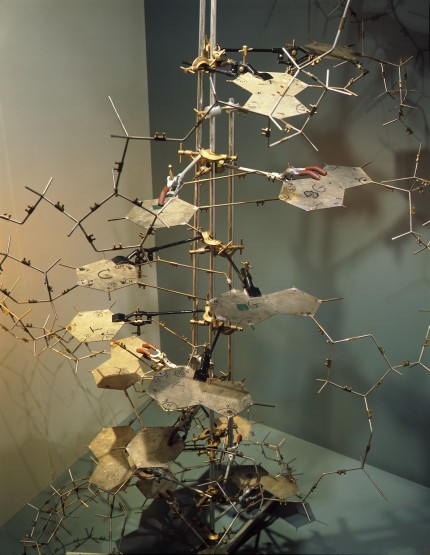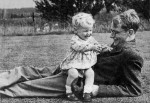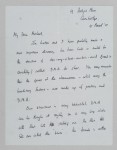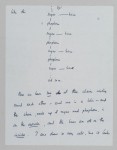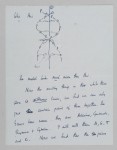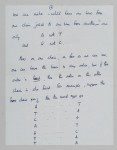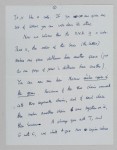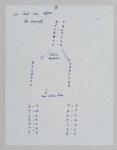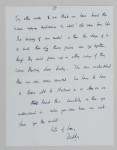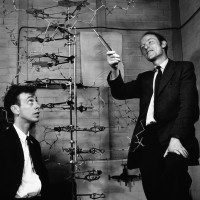 On February 28th, 1953, Francis Crick and James Watson figured out that DNA had a double-helix structure by creating a model out of bits of stuff in the lab and comparing it to X-ray diffraction data collected by X-ray crystallographer Rosalind Franklin and molecular biologist Maurice Wilkins. It was a discovery to write home about, and on March 19th, Crick did just that, sending a letter to his 12-year-old son Michael (who was not actually home at the time but rather in boarding school) describing their model, the double-helix sugar-phosphate backbone zipped together with basepairs of guanine and cytosine, adenine and thymine.
On February 28th, 1953, Francis Crick and James Watson figured out that DNA had a double-helix structure by creating a model out of bits of stuff in the lab and comparing it to X-ray diffraction data collected by X-ray crystallographer Rosalind Franklin and molecular biologist Maurice Wilkins. It was a discovery to write home about, and on March 19th, Crick did just that, sending a letter to his 12-year-old son Michael (who was not actually home at the time but rather in boarding school) describing their model, the double-helix sugar-phosphate backbone zipped together with basepairs of guanine and cytosine, adenine and thymine.
This letter, written more than a month before Watson and Crick published their first paper in the April 25th, 1953, issue of the journal Nature, contains the first written description of DNA as a “code” that is replicated. In addition to marking a watershed moment in the history of science, it’s a model of clarity and science writing for a popular audience that I think should be included in every school science textbook published. It’s also really sweet in a my-dad-is-a-serious-scientist sort of way.
Jim Watson and I have probably made a most important discovery. We have built a model for the structure of des-oxy-ribose-nucleic-acid (read it carefully) called D.N.A. for short. You may remember that the genes of the chromosomes — which carry the hereditary factors — are made up of protein and D.N.A.
Our structure is very beautiful. D.N.A. can be thought of roughly as a very long chain with flat bits sticking out. The flat bits are called the “bases”. […]
Now we have two of these chains winding round each other — each one is a helix — and the chain, made up of sugar and phosphorus, is on the outside, and the bases are all on the inside. […]
Now the exciting thing is that while these are 4 different bases, we find we can only put certain pairs of them together. The bases have names. They are Adenine, Guanine, Thymine & Cytosine. I will call them A, G, T and C. Now we find that the pairs we can make — which have one base from one chain joined to one base from another — are only A with T and G with C.
Now on one chain, as far as we can see, one can have the bases in any order, but if their order is fixed, then the order on the other chain is also fixed. […]
It is like a code. If you are given one set of letters you can write down the others.
Now we believe that the D.N.A. is a code. That is, the order of the bases (the letters) makes one gene different from another gene (just as one page of print is different from another). You can now see how Nature makes copies of the genes. Because if the two chains unwind into two separate chains, and if each chain then makes another chain come together on it, then because A always goes with T, and G with C, we shall two copies where we had one before. […]
In other words, we think we have found the basic copying mechanism by which life comes from life. The beauty of our model is that the shape of it is such that only these pairs can go together, though they could pair up in other ways if they were floating about freely. You can understand that we are very excited. We have to have a letter off to Nature in a day or so. Read this carefully so that you understand it. When you come home we will show you the model.
Lots of love,
Daddy
I’ve snipped out the hand-drawn illustrations, but you can read a transcript of the full letter with the diagrams included here. Crick’s handwriting is very legible so you can easily read the full letter with diagrams in the pictures below.
Michael did what his father told him to do and read the letter carefully over and over again. He was sick with the flu and confined to quarters, so he had plenty of time on his own to reread it and memorize “des-oxy-ribose-nucleic-acid” and grasp how the code could be copied.
The little boy is 72 now and kept the letter for 60 years. He put it up for auction this year, the 60th anniversary of its writing, because it was idling away in storage along with Francis Crick’s Nobel Prize, which Crick,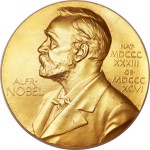 James Watson and Maurice Wilkins (Rosalind Franklin had died in 1958 and prizes are not awarded posthumously), received in 1962 after the immense significance of their discovery became clear. Michael and his family decided it was time to let go of these precious milestones in the history of science. The proceeds would be split, with 20% from the sale of the medal going to the Francis Crick Institute in London and 50% from the sale of the letter going to the Salk Institute in La Jolla which employed Crick for 27 years after his mandatory retirement from the Medical Research Council in Cambridge, England, the laboratory where Watson and Crick made the double-helix model.
James Watson and Maurice Wilkins (Rosalind Franklin had died in 1958 and prizes are not awarded posthumously), received in 1962 after the immense significance of their discovery became clear. Michael and his family decided it was time to let go of these precious milestones in the history of science. The proceeds would be split, with 20% from the sale of the medal going to the Francis Crick Institute in London and 50% from the sale of the letter going to the Salk Institute in La Jolla which employed Crick for 27 years after his mandatory retirement from the Medical Research Council in Cambridge, England, the laboratory where Watson and Crick made the double-helix model.
On April 10th, 2013, the letter sold at a Christie’s auction in New York for $5.3 million, $6,059,750 including buyer’s premium. This is a world record price for a letter sold at public auction. The buyer has chosen to remain anonymous, surprise, surprise. I hope he’s willing to lend it to institutions for exhibition.
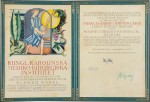 Crick’s Nobel prize medal and diploma were sold by Heritage Auctions on April 11th. They were bought for $2,270,500 by Jack Wang, CEO of a Shanghai-based biomedical firm who plans to display them to encourage the company’s scientists to reach great research heights.
Crick’s Nobel prize medal and diploma were sold by Heritage Auctions on April 11th. They were bought for $2,270,500 by Jack Wang, CEO of a Shanghai-based biomedical firm who plans to display them to encourage the company’s scientists to reach great research heights.
The original model of the double-helix made by Crick and Watson was dismantled, but in 1973 it was recreated using many of the original metal plates representing the bases. The reconstructed model is now part of the permanent collection of London’s Science Museum.
